Lifestyle
Tanning Oil Stains? Here's Your Solution
Prevent tanning oil stains from ruining your clothes with these simple tips that will leave you wondering how you ever managed without them!
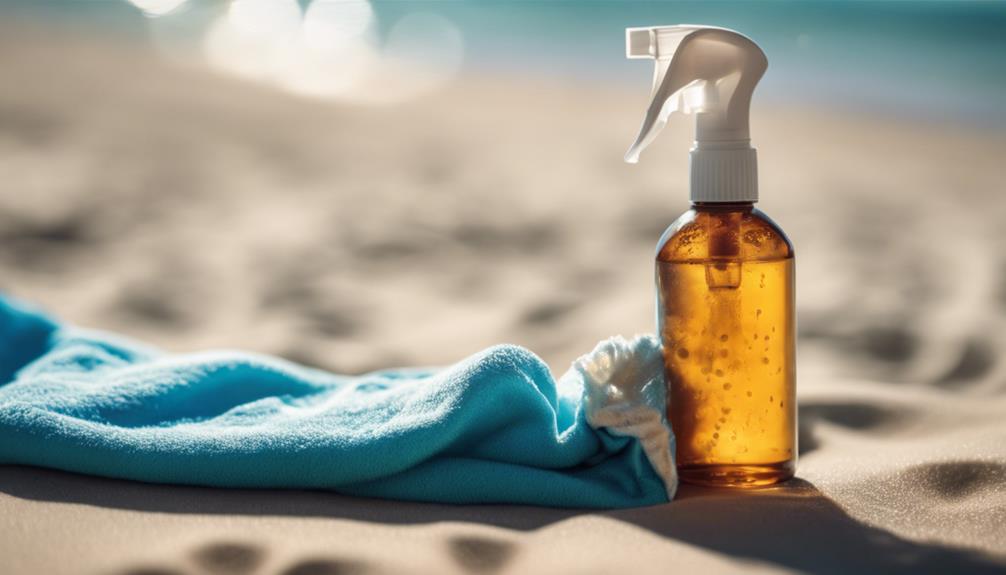
Tanning oil stains don't have to ruin your clothes. Start by blotting the stain gently with paper towels to lift excess oil. Apply a few drops of liquid dish soap directly onto the stain and let it sit for 5-10 minutes before rinsing with cold water. If the stain remains, repeat the process or try mixing equal parts water and white vinegar for tougher spots. Always check your fabric care label for best washing instructions. Finally, keep an eye on the drying process and inspect for any lingering stains. Discover more effective tips to keep your clothes stain-free!
Key Takeaways
- Blot excess tanning oil immediately with paper towels to prevent it from setting into the fabric.
- Apply liquid dish soap directly to the stain and let it sit for 5-10 minutes before rinsing with cold water.
- For stubborn stains, consider using shampoo or a mixture of water and white vinegar for effective grease breakdown.
- Always check the care label for specific washing and drying instructions to avoid damaging the fabric.
Assessing the Stain
When you encounter a tanning oil stain, it's essential to assess the fabric type and the stain's age to choose the best cleaning method.
Start by examining the fabric; different materials require different approaches. Check if the stain is fresh or has set in, as this will influence your treatment strategy.
Next, evaluate the stain size; a small spot may only need spot treatment, while larger areas might require professional help. Inspect the extent of damage to the fabric, as this will guide your cleaning decisions.
Always review the care tag for specific cleaning instructions related to the fabric, ensuring you use safe methods that won't cause further harm.
The quicker you assess these factors, the better your chances of successful stain removal.
Initial Treatment Steps
To effectively tackle a tanning oil stain, act quickly by blotting any excess oil with paper towels to prevent it from setting further into the fabric.
Gently press down on the stain, replacing the towels frequently until no oil transfers. Avoid rubbing, as this can spread the stain and damage the fabric. Use clean, dry towels for maximum absorption, ensuring you maintain a gentle touch throughout the process.
If the stain persists, consider applying a few drops of liquid dish soap directly onto the affected area. Let it sit for about 5-10 minutes, allowing the soap to penetrate the fabric.
Afterward, rinse thoroughly with cold water to prepare for further cleaning steps.
Effective Washing Techniques

How do you guarantee effective washing techniques for tanning oil stains?
Start by applying liquid dish soap directly onto the stain and gently rub it into the fabric to help it penetrate.
Let the soap sit for 5-10 minutes to enhance its effectiveness.
Rinse the area thoroughly with cold water to remove any soap residue.
Next, check the care label and use hot water for the wash, as it helps break down stubborn oil stains.
After washing, perform a spot check to confirm the stain is gone.
If any remnants remain, reapply stain remover and wash again.
Persistence is key—don't hesitate to repeat the process until the stain vanishes completely.
Drying Procedures
After washing, it's important to choose the right drying procedure to guarantee any remaining traces of the tanning oil stain are completely removed.
Start by checking the care tag; if it allows for machine drying, use a low heat setting. This helps avoid damaging the fabric while ensuring thorough drying. Keep an eye on the drying process to prevent overheating.
If your item is delicate, consider air-drying instead. Lay it flat to maintain its shape, or hang it in a well-ventilated area.
Before you put the item away, inspect it for any signs of the stain. If you spot any remnants, repeat the washing process before drying again. Persistence is key to achieving a stain-free finish.
Post-Treatment Care
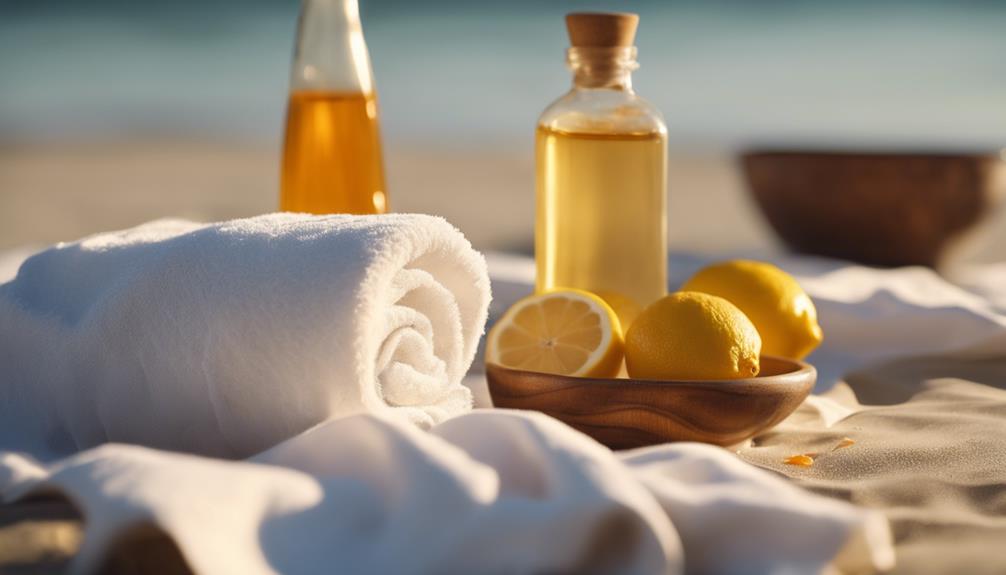
Inspecting your fabric for any remaining traces of the tanning oil stain is vital before storing or using the item again. If you spot any lingering marks, it's important to address them promptly.
You should always check the care label for specific drying instructions; using a low heat setting is generally safest to avoid further damage. Monitor the drying process closely, and consider air-drying delicate items to maintain their shape.
After drying, inspect the fabric one last time. If any stains persist, don't hesitate to repeat the treatment process. Remember, persistence is key for complete stain removal.
Taking these steps guarantees your favorite garments remain in great condition and ready for your next outing.
Prevention Strategies
To keep your favorite garments looking their best and prevent future tanning oil stains, it's important to adopt a few proactive strategies. Start by applying tanning oil at least 15 minutes before dressing, and consider using a towel or cover-up as a barrier. Choosing darker clothing can help minimize the visibility of any stains. Additionally, limit your tanning oil application to reduce the risk of staining.
Here's a quick reference table to help you remember these strategies:
| Strategy | Description | Benefits |
|---|---|---|
| Apply oil early | Apply 15 minutes before dressing | Reduces direct fabric contact |
| Use a barrier | Use a towel or cover-up | Protects garments from stains |
| Choose darker clothing | Opt for darker colors | Minimizes visible stains |
| Limit oil application | Use less tanning oil | Reduces overall stain risk |
| Regular fabric care | Monitor and treat stains quickly | Enhances longevity of garments |
Alternative Cleaning Methods

Exploring alternative cleaning methods can provide effective solutions for tackling stubborn tanning oil stains on your fabrics.
One approach you can try is applying shampoo directly to the stain, as it's designed to break down grease.
Mix equal parts water and white vinegar for another powerful solution; apply it to the stain and let it sit for about 30 minutes before rinsing.
For tough spots, consider using a commercial stain remover, like Shout gel, and follow up with a second wash cycle if needed.
Don't hesitate to experiment with these methods; you might find the perfect combination that works for your specific fabric.
Frequently Asked Questions
Can Tanning Oil Stains Affect Different Fabric Types Differently?
Yes, tanning oil stains affect different fabric types uniquely. Delicate fabrics might absorb oil more easily, while sturdier materials can withstand treatment better. Always assess fabric carefully before deciding on a cleaning method to protect it.
What Tools Do I Need for Stain Removal?
Imagine standing on a battlefield of stubborn stains. You'll need paper towels, liquid dish soap, a gentle scrub brush, and a washing machine—your trusty allies in the quest for spotless fabric. Don't forget patience!
How Can I Prevent My Clothes From Getting Stained in the First Place?
To prevent stains, apply tanning oil 15 minutes before dressing, use a towel as a barrier, and choose darker clothing. Keeping a watchful eye on your garments helps maintain their pristine condition.
Are There Specific Brands Recommended for Stain Removal?
For stain removal, you might try brands like Shout, OxiClean, or Zout. Each has its strengths, so testing a few can help you find what works best for your specific stains and fabrics.
Is It Safe to Use Bleach on Tanning Oil Stains?
When it comes to tanning oil stains, using bleach can be a double-edged sword. It might damage your fabric, so it's best to stick to safer cleaning methods unless you're dealing with white materials.
Conclusion
Now that you're equipped with the right techniques to tackle tanning oil stains, you can confidently enjoy the sun without worrying about your clothes.
For example, imagine you're at a beach party and accidentally spill tanning oil on your favorite shirt. By quickly treating the stain with dish soap and washing it properly, you can save that shirt and keep making sunny memories.
So, go ahead, soak up the sun and remember these tips for hassle-free fun!
Lifestyle
Unlock Your Best Tan With Smart Sessions
Incorporate tailored tanning sessions to enhance your glow and discover secrets for maintaining a radiant tan that lasts!

You can access your best tan by tailoring your sessions to your skin type. Start with short sessions and gradually increase their length, keeping in mind that fair skin needs fewer visits than darker tones. Preparing your skin is essential: exfoliate 24 hours prior and hydrate well. After tanning, moisturize immediately to keep your glow vibrant. Aim for regular sessions, but know when to ease back to maintain your color effectively. By understanding your skin and following these steps, you'll achieve a radiant tan. There's more to explore on enhancing your tanning experience and keeping it fresh!
Key Takeaways
- Assess your skin type using the Fitzpatrick Scale to determine optimal tanning frequency for best results.
- Prepare your skin by exfoliating 24 hours prior and arriving makeup-free for even product application.
- Start with short tanning sessions to gauge your skin's response, gradually increasing duration as needed.
- Maintain hydration by drinking water and using a moisturizer before and after tanning to enhance results.
Understanding Your Skin Type
To reveal your best tan, start by identifying your skin type using the Fitzpatrick Scale, which helps you tailor your tanning strategy effectively. This scale categorizes skin into six types based on how easily it burns and tans.
If you have fair skin, you'll want to begin with brief sessions to establish a base tan, while medium skin types can handle slightly longer sessions. Olive skin types can enjoy more frequent sessions, but even darker skin must exercise caution.
Follow the recommended frequencies: fair (1-2 times a week), medium (2-3), olive (3-4), and darker (4-5). Adjust your session duration as your skin adapts to guarantee ideal results without overexposure.
Preparing for Your Session
Exfoliating your skin 24 hours before your tanning session helps eliminate dead skin cells, ensuring a smooth and even tan.
After exfoliation, it's essential to hydrate your skin adequately; dry skin doesn't tan well. Make sure to moisturize regularly leading up to your session to keep your skin in ideal condition.
When you arrive for your tanning session, come with clean, makeup-free skin. This allows for an even application of the tanning product or UV rays.
Avoid using any lotions or oils that might interfere with the tanning process. By following these simple steps, you'll set the stage for achieving that beautiful, bronzed glow you desire.
Preparing properly maximizes your results and enhances your tanning experience.
Managing Tanning Sessions
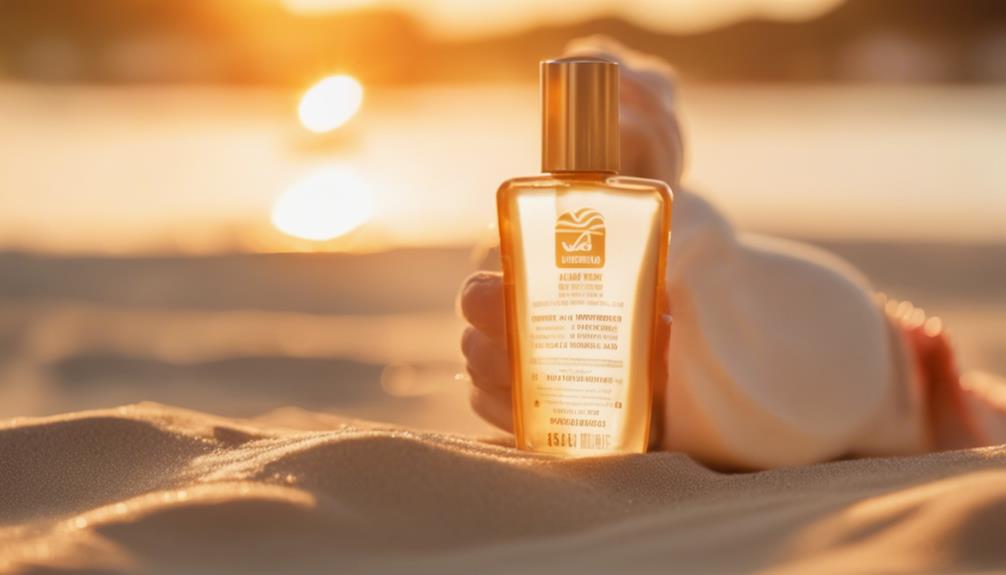
Managing your tanning sessions effectively is essential for achieving a deep and even tan while minimizing the risk of skin damage.
Start with short sessions to gauge your skin's response, gradually increasing the duration as your skin adapts. Aim for a balanced schedule—limit yourself to one session per day.
For initial color development, you might need 3-5 sessions, especially if you have lighter skin. Once you've reached your desired shade, cut back to 2 sessions weekly for maintenance.
Consider alternating tanning beds to benefit from different wavelengths, promoting an even tan and preventing overexposure in certain areas.
Always listen to your skin and adjust your routine as needed to keep it healthy and glowing.
Post-Tanning Care
Applying moisturizer immediately after tanning helps prevent peeling and keeps your skin hydrated.
To maintain that gorgeous glow, incorporate these essential post-tanning care tips into your routine:
- Use a professional tan extender to prolong your tan and enhance its vibrancy.
- Stay hydrated by drinking plenty of water; it's vital for keeping your skin looking its best.
- Avoid hot showers or baths for the first 24 hours post-tan to preserve your color.
Health and Safety Tips

Understanding your skin's limits is essential to enjoying a safe and effective tanning experience. Always start with short tanning sessions to gauge how your skin reacts.
If you have fair skin, limit your sessions to 1-2 times a week, while darker skin types can go up to 4-5 times. Hydration is key—drink plenty of water and use a good moisturizer before and after tanning.
Rotate your position during sessions to avoid uneven tan lines. Keep an eye on your skin; if you notice any irritation or redness, give it a break.
Above all, patience is crucial; gradual exposure leads to the best results without damaging your skin. Stay informed about safety practices for a healthier tanning experience.
Frequently Asked Questions
How Can I Tell if a Tanning Bed Is Safe?
To determine if a tanning bed's safe, check for recent certifications, guarantee it's well-maintained, and confirm the bulbs are functioning properly. You should also read reviews and ask staff about their safety practices.
What Are the Signs of Overexposure to UV Rays?
Signs of overexposure to UV rays include redness, swelling, blistering, and peeling skin. You might also experience discomfort, fever, or chills. If you notice these symptoms, it's essential to minimize further sun exposure immediately.
Can I Tan if I Have a Skin Condition?
You can tan with a skin condition, but it's essential to consult your dermatologist first. They'll help you understand any risks and recommend safe tanning practices tailored to your specific needs. Stay cautious!
How Long Does a Tan Typically Last?
A tan typically lasts about 7 to 10 days, depending on your skin type and care. Moisturizing and exfoliating can help extend its life, while sun exposure can fade it more quickly.
Are There Any Foods That Enhance Tanning Results?
Eating foods rich in carotenoids, like carrots, can enhance your tan. For instance, when you add these to your diet, you might notice a deeper, more golden hue in your skin after tanning sessions.
Conclusion
As you bask in the sun's warm embrace, remember that your journey to the perfect tan is a blend of care and knowledge.
With your skin glowing like golden sand, you'll revel in the beauty of your hard work.
Embrace each session, savoring the gentle warmth that deepens your hue, and don't forget to nourish your skin afterward.
With every step, you're not just tanning; you're crafting a radiant, sun-kissed masterpiece that shines with confidence.
Lifestyle
Tanning Safely: Tailor Your Session Strategy
How to achieve a beautiful tan while minimizing risks—discover essential strategies tailored to your skin type for safe tanning!

Tanning safely means you need to tailor your session strategy based on your skin type. First, identify where you fall on the Fitzpatrick Scale. For Types I and II, keep sessions to 5-10 minutes, while Types III to V can go slightly longer. Always allow at least 48 hours between sessions to let your skin recover. Prioritize hydration and use sunscreen to protect against UV damage. Be mindful of any skin reactions—stinging or redness indicates it's time to adjust. By following these tips, you can achieve a healthy tan while minimizing risks. More insights await you on fine-tuning your technique!
Key Takeaways
- Identify your skin type using the Fitzpatrick Scale to customize tanning sessions and minimize the risk of burns.
- Start with shorter tanning sessions, especially for fair skin types, and gradually increase duration as your skin adapts.
- Space out tanning sessions by at least 48 hours to allow for skin recovery and prevent overexposure.
- Hydrate and exfoliate before tanning to maintain skin health and ensure an even tan application.
Understanding Skin Types
Understanding your skin type is essential for customizing a safe tanning plan that minimizes risks and maximizes results. The Fitzpatrick Scale classifies skin from I to VI, helping you identify how your skin reacts to UV exposure.
If you have Type I skin, you burn easily and should avoid direct sunlight. Type II skin can tan, but you need to start with cautious, gradual exposure.
Knowing your skin type allows you to tailor your tanning sessions, ensuring you don't overdo it and risk irritation or burns. When indoor tanning, be aware of how your skin responds to UV light, and adjust your schedule accordingly.
This knowledge empowers you to achieve a beautiful tan while keeping your skin safe and healthy.
The Role of Melanin
Melanin plays an essential role in tanning by providing your skin with natural protection against sun damage when exposed to UV light.
When you spend time in the sun or a tanning bed, your melanocytes kick into gear, producing melanin in response to UV exposure. This process not only helps darken your skin but also enhances your skin's defense against harmful rays.
Gradual exposure is key; it allows your skin to properly oxidize melanin, leading to a deeper, more even tan.
Remember, the specific UV rays emitted by indoor tanning equipment can vary, so following guidelines is vital to respect your skin's sensitivity and avoid any adverse reactions.
Your skin's health should always come first.
Session Frequency and Duration

To achieve a safe and effective tan, it is vital to customize the frequency and duration of your tanning sessions based on your skin type and sensitivity. Start with shorter sessions, especially if you have fair skin, and gradually increase as your skin adapts. It is important to allow at least 48 hours between sessions for skin recovery. Here's a quick reference table to help you determine session frequency and duration:
| Skin Type | Session Duration |
|---|---|
| Type I & II | 5-10 minutes |
| Type III | 10-15 minutes |
| Type IV & V | 15-20 minutes |
Consult facility staff for personalized recommendations, ensuring you achieve your desired tan safely. Remember, patience is key!
Preventing Overexposure
Preventing overexposure during tanning is essential for maintaining skin health and avoiding burns.
Start your tanning sessions with shorter durations; this allows your skin to adapt to UV exposure gradually.
Always space out your sessions, ideally waiting at least 48 hours between them, to give your skin time to recover and build melanin.
Avoid multiple sessions in a single day, as this increases your risk of burns and long-term damage.
Pay attention to how your skin reacts; if you notice stinging or redness, it's a signal to adjust your exposure time.
Healthy Tanning Practices

Maintaining healthy tanning practices goes hand in hand with preventing overexposure, ensuring your skin stays protected while you achieve that desired glow. Implementing a balanced routine is key. Follow these tips for ideal results:
| Practice | Importance | Frequency |
|---|---|---|
| Hydrate | Keeps skin moisturized | Daily |
| Exfoliate | Promotes even tan application | 24 hours before |
| Use Sunscreen | Protects against UV damage | Every session |
| Apply Tan Extenders | Prolongs tan duration | After each session |
| Monitor Skin Reaction | Adjust tanning practices accordingly | After each session |
Frequently Asked Questions
What Should I Wear During My Tanning Sessions?
During your tanning sessions, wear comfortable, minimal clothing to expose as much skin as possible. Consider using swimwear or special tanning apparel to achieve an even tan while protecting areas you don't want to darken.
Can I Use Sunscreen While Tanning Indoors?
While you're channeling your inner beach bum, it's best to skip sunscreen during indoor tanning. It blocks UV rays, preventing melanin production. Instead, prioritize gradual exposure for that sun-kissed glow without compromising skin health.
How Do I Know When to Stop Tanning?
You'll know to stop tanning when your skin starts showing signs of redness, stinging, or discomfort. Pay attention to your body's signals and adjust your sessions to prevent overexposure and potential skin damage.
Are There Any Foods That Enhance Tanning Results?
Yes, certain foods can enhance tanning results. Foods rich in carotenoids, like carrots and sweet potatoes, boost melanin production. Staying hydrated and consuming antioxidants also helps keep your skin healthy while you tan.
How Can I Even Out Tan Lines?
To even out tan lines, exfoliate the area gently, then apply a self-tanner to the lighter spots. Gradually build color by using a gradual tanning lotion, ensuring an even and natural-looking tan over time.
Conclusion
To sum up, safe tanning is all about knowing your skin and making informed choices.
By understanding your skin type and respecting its limits, you can enjoy the sun without compromising your health.
Isn't it worth taking the time to develop a personalized tanning strategy that prioritizes your skin's well-being?
Remember, a beautiful tan should not come at the cost of your skin's health.
Embrace these practices, and you'll glow confidently while keeping your skin safe.
Lifestyle
Protect Your Skin: Tanning Bed Dangers Revealed
Discover the hidden dangers of tanning beds and learn how to safeguard your skin from serious risks that could change your life forever.

Tanning beds might seem like a quick way to achieve a bronzed look, but they pose serious risks to your skin. These beds emit harmful UV rays that elevate your chances of developing skin cancer, especially melanoma, by a staggering 75% if you're under 20. Plus, they contribute to premature aging, leaving your skin damaged and prone to issues like redness and peeling. The myth that a base tan protects you is just that—a myth. Choosing safer alternatives or preparing your skin properly can help you avoid these dangers. Stick with us to discover how to protect your skin effectively.
Key Takeaways
- Tanning beds significantly increase the risk of skin cancer, particularly melanoma, by 75% for users under 20 years old.
- UVA rays from tanning beds damage DNA, accelerating skin aging and increasing cancer risk.
- The myth of a "base tan" is misleading—tanning beds cause more skin damage instead of providing protection.
- Overexposure can lead to immediate skin issues such as redness, peeling, and tenderness.
Health Risks of Tanning Beds
Tanning beds pose serious health risks, considerably increasing your chances of developing skin cancer, especially melanoma, if you're under 20. Statistics show a staggering 75% increased risk for young adults using these beds.
The UVA rays emitted damage your DNA, paving the way for cancer and causing premature aging. You might believe that a base tan offers protection, but that's a myth; it only exacerbates skin damage.
Overexposure can lead to immediate skin issues like redness, tenderness, and peeling. It's essential to recognize that your skin is the body's largest organ and needs careful treatment.
Prioritizing awareness of these risks can help you make informed choices about tanning and protect your skin's long-term health.
Myths About Tanning
Many people hold misconceptions about tanning, believing it to be a harmless way to achieve a bronzed look without considering the serious risks involved.
One common myth is that tanning beds provide a safe base tan, but in reality, they only increase your skin damage and cancer risk.
Another misconception is that tanning helps with vitamin D absorption, yet the UV exposure from tanning beds does more harm than good.
Many think that they can tan safely without proper precautions, but overexposure leads to painful burns and long-term skin issues.
Finally, some assume that a darker tan is a sign of health, when it actually signals skin stress and damage.
It's time to debunk these myths and prioritize skin health.
Safety Guidelines for Users

Following proper safety guidelines can greatly reduce the risks associated with tanning bed use.
Limit your sessions according to the manufacturer's recommendations to avoid skin damage.
Always wear FDA-approved protective eyewear that fits snugly to shield your eyes from harmful UV rays.
Before you tan, ask about the salon's cleaning protocols to guarantee the beds are properly disinfected; using disposable covers can enhance hygiene.
It's wise to consult a dermatologist prior to starting tanning sessions, particularly if you have specific skin concerns.
Keep track of your skin's response to tanning and be alert for signs of overexposure, like redness or peeling.
Prioritizing these safety measures helps protect your skin while enjoying the tanning experience.
Alternatives to Tanning Beds
Safe alternatives to tanning beds, like self-tanning lotions and sprays, let you achieve a bronzed look without the harmful effects of UV exposure.
You can opt for professional spray tans for an instant glow or choose gradual tanning lotions that build color over time. If you need a quick fix, bronzing powders can deliver immediate results.
Using sunless tanning products containing DHA is a safer choice compared to traditional methods.
Remember, it's also essential to emphasize your natural skin tone by maintaining proper skincare and consistently applying sunscreen.
With these alternatives, you can enjoy a beautiful tan while prioritizing your skin's health and avoiding the long-term risks associated with tanning beds.
Pre-Tanning Skin Preparation
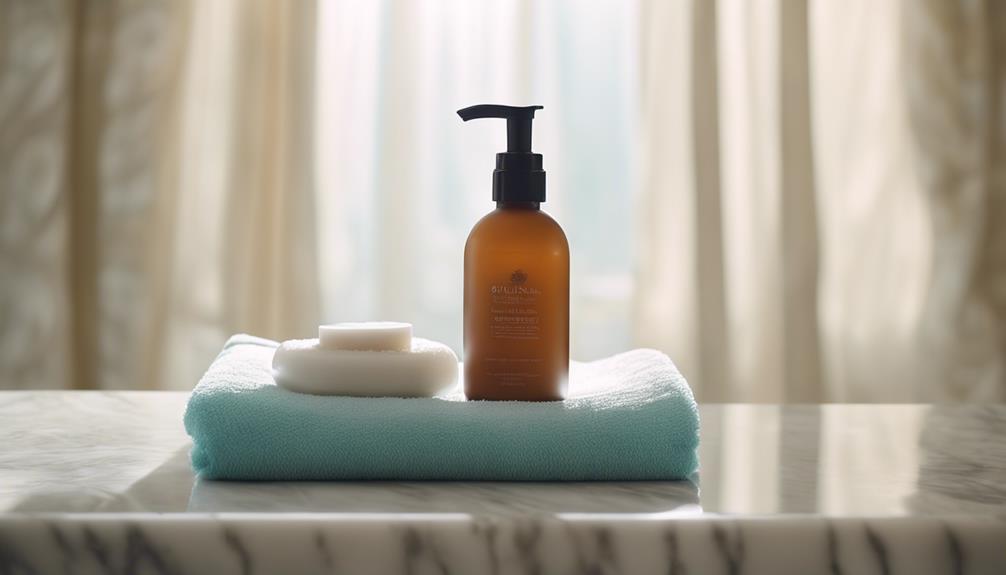
Preparing your skin for tanning involves exfoliating to confirm an even color and moisturizing to prevent dry patches that could affect the final result. Start by exfoliating your skin gently, removing dead cells for a smooth canvas. Next, apply a good moisturizer, focusing on areas prone to dryness like elbows and knees. Avoid using scented or oily products before tanning, and make certain to shave or wax at least 24 hours prior to your session for ideal results.
| Step | Action | Notes |
|---|---|---|
| Exfoliate | Use a gentle scrub | Focus on rough areas |
| Moisturize | Apply a hydrating lotion | Avoid oils and fragrances |
| Prep Timing | Shave or wax 24 hours in advance | Confirms skin is smooth |
Choosing Safe Tanning Products
When it comes to selecting tanning products, prioritize those designed to minimize skin damage while providing a natural-looking glow.
Look for self-tanning lotions and sprays that contain DHA, which safely darkens your skin without the risks associated with UV exposure. Gradual tanning lotions allow you to build color over time, giving you better control over your desired shade.
Always choose bronzers that match your skin tone for the most natural appearance, and opt for matte finishes to avoid excessive shine.
Remember to test products in natural light to guarantee an even application. Using tanning mitts can help achieve a streak-free look, making your tanning routine safer and more effective.
Your skin will thank you!
Recognizing Overexposure Symptoms
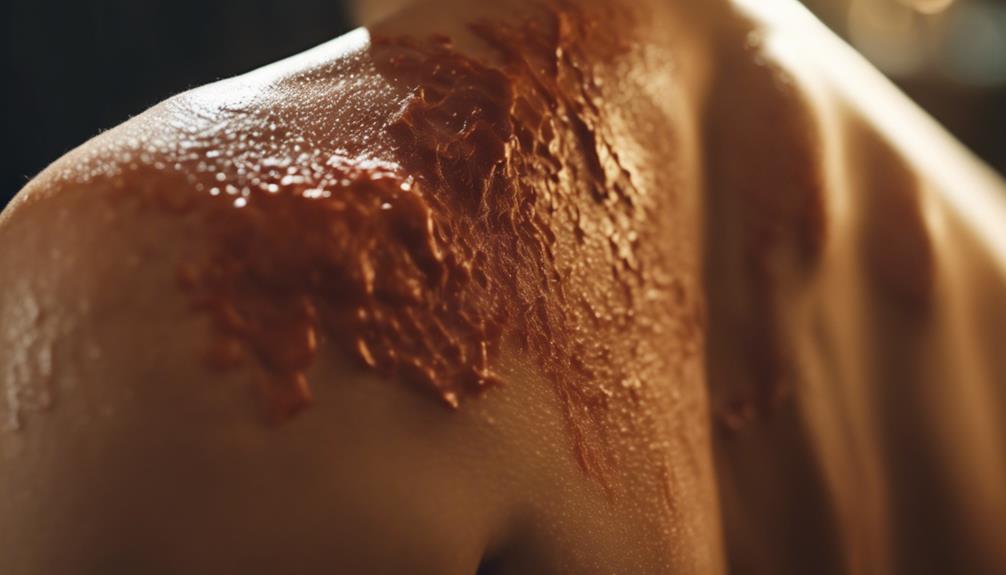
Recognizing the symptoms of overexposure to UV rays is essential for maintaining healthy skin and preventing long-term damage.
If you notice redness, tenderness, or a burning sensation on your skin after a tanning session, it's a clear sign you've overdone it.
Peeling skin indicates your body is trying to heal from the damage, while dizziness can signal more severe reactions.
Don't ignore these symptoms; they're your body's way of telling you to take a break.
To protect your skin, keep track of how often you tan and limit your sessions.
Always prioritize skin health over a temporary glow, and consider alternatives like self-tanners for a safer, healthier approach to achieving that bronzed look.
Frequently Asked Questions
How Often Should I Get Skin Checks After Using Tanning Beds?
You should get skin checks at least once a year after using tanning beds. If you notice any changes or new moles, see a dermatologist sooner to guarantee your skin stays healthy and protected.
What Are the Long-Term Effects of Tanning Bed Use on Skin Health?
Tanning bed use can lead to long-term skin damage, including premature aging, increased risk of skin cancer, and DNA damage. You should consider safer alternatives to protect your skin's health and appearance over time.
Can Tanning Beds Provide Any Benefits Beyond Cosmetic Tanning?
Tanning beds might seem like a quick fix, but they don't offer real benefits beyond cosmetic tanning. Instead of seeking a temporary glow, consider healthier alternatives that protect your skin and overall well-being.
Are There Specific Skin Types More Susceptible to Tanning Bed Damage?
Yes, certain skin types, especially fair or sensitive ones, are more susceptible to tanning bed damage. If your skin burns easily or has a history of issues, you should be particularly cautious about using tanning beds.
How Do Tanning Beds Compare to Natural Sunlight Exposure in Terms of Risk?
Tanning beds and natural sunlight both expose you to harmful UV rays, increasing skin cancer risk. However, tanning beds often emit more concentrated UVA rays, heightening the danger. Consider safer alternatives for your skin's health.
Conclusion
In your quest for that perfect tan, it's easy to overlook the risks of tanning beds.
Coincidentally, while you might think you're boosting your glow, you could be increasing your chances of skin cancer considerably.
Remember, prioritizing your skin health today could mean a brighter, safer future.
Instead of artificial tanning, consider sunless options or natural methods that keep your skin radiant without the dangers.
Protect yourself—your skin will thank you!
-

 Vetted2 months ago
Vetted2 months ago14 Best Personalized Father's Day Gifts for Your Husband – Show Him You Care
-

 Alfresco1 month ago
Alfresco1 month agoAlfresco Stacker Doors: Seamless Indoor-Outdoor Living!
-

 Craft and Textiles3 months ago
Craft and Textiles3 months ago15 Best Places to Buy Appliances for Your Home – Top Retailers Reviewed
-

 Decorative Throws3 months ago
Decorative Throws3 months agoIs It Better to Dry Clean Blankets?
-

 Tableware and Dining Accessories3 months ago
Tableware and Dining Accessories3 months agoWhat Is the Meaning of the Word Tableware
-

 Tableware and Dining Accessories3 months ago
Tableware and Dining Accessories3 months agoWhat Is the Hindi Meaning of Tableware
-

 Craft and Textiles3 months ago
Craft and Textiles3 months ago15 Best Cordless Mowers for Effortless Lawn Care – Top Picks of 2024
-

 Yarn3 months ago
Yarn3 months agoIs Yarn Natural or Manmade? Unravel the Truth






















